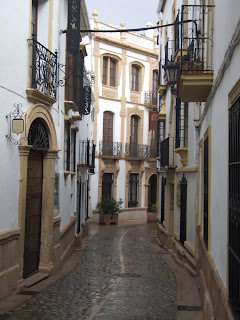 We left Olvera about 10'ish on a cold, foggy morning to drive the 45 minutes south to Ronda. Driving through the town over the "Puente Nuevo" (New Bridge) we parked in the old part of town near the Plaza Ruedo Alameda.
We left Olvera about 10'ish on a cold, foggy morning to drive the 45 minutes south to Ronda. Driving through the town over the "Puente Nuevo" (New Bridge) we parked in the old part of town near the Plaza Ruedo Alameda.We walked through the old Moorish town walls and started our exploration.
 The Plaza Rueda Alameda as viewed from the old town wall.
The Plaza Rueda Alameda as viewed from the old town wall.
 After a short uphill walk we came to the Plaza Duquesa de Parcent, a beautiful square surrounded by stunning buildings.
After a short uphill walk we came to the Plaza Duquesa de Parcent, a beautiful square surrounded by stunning buildings. This unidentified church was in one corner of the square. Inside, it was ornately decorated with a beautiful altar and religious artefacts and a segregated area where nuns were sat reading. I didn't take any pictures as it may have been disrespectful but it is well worth a visit.
This unidentified church was in one corner of the square. Inside, it was ornately decorated with a beautiful altar and religious artefacts and a segregated area where nuns were sat reading. I didn't take any pictures as it may have been disrespectful but it is well worth a visit. This is Ronda City Hall, the seat of local government, built in 1734.
This is Ronda City Hall, the seat of local government, built in 1734.
 Just around the corner from the City Hall is the Plaza Mondragón where the Palacio Mondragón is located. We didn't go in as there were a couple of tour groups waiting outside. So perhaps another day.
Just around the corner from the City Hall is the Plaza Mondragón where the Palacio Mondragón is located. We didn't go in as there were a couple of tour groups waiting outside. So perhaps another day. The view towards the famous gorge from the Plaza Maria Auxiliadora.
The view towards the famous gorge from the Plaza Maria Auxiliadora.
We spotted this couple on their way to a re-enactment of some kind. They were happy to pose for a picture.

A horse and carriage used to convey visitors around Ronda.


This impressive tiled plaque shows the gorge and the precarious position of Ronda perched above it.
 Looking towards the Puente Nuevo bridge which spans the gorge.
Looking towards the Puente Nuevo bridge which spans the gorge.
 Looking down Calle Cuesta de Santa Domingo towards the Palace of the Arabian King, visible at the bottom of the picture.
Looking down Calle Cuesta de Santa Domingo towards the Palace of the Arabian King, visible at the bottom of the picture. At the bottom of the street, we came to the Palacio del Marqués de Salvatierra dating back to the 17th century.
At the bottom of the street, we came to the Palacio del Marqués de Salvatierra dating back to the 17th century. This chap was also looking around and asked us to take a picture. His name was Stephen Salvatierra and amazingly he was a direct descendant of the original inhabitants of the palace. He was an American, on holiday in Spain for three weeks, visiting Ronda for a few days tracing his family history.
This chap was also looking around and asked us to take a picture. His name was Stephen Salvatierra and amazingly he was a direct descendant of the original inhabitants of the palace. He was an American, on holiday in Spain for three weeks, visiting Ronda for a few days tracing his family history.
He was a really pleasant guy, slightly disappointed that the palace was not open to the public but was going off to see if somehow he could gain access. We hope he was successful.
 The Hotel Ronda, a Hostal on the road up from the palace. Anne took a shine to it's beautifully decorated window boxes.
The Hotel Ronda, a Hostal on the road up from the palace. Anne took a shine to it's beautifully decorated window boxes. Opposite the Hostal was the Palace of the Arabian King, next to which were some ornamental gardens, accessible for a small fee. In need of complete restoration, the building dates back to the 18th century.
Opposite the Hostal was the Palace of the Arabian King, next to which were some ornamental gardens, accessible for a small fee. In need of complete restoration, the building dates back to the 18th century. The Alminar de San Sebastián, the last remnant of a mosque believed to date back to the 14th century.
The Alminar de San Sebastián, the last remnant of a mosque believed to date back to the 14th century. We really enjoyed this walkabout. Lots of lovely historic buildings, cobbled streets and beautiful plaza's.
We really enjoyed this walkabout. Lots of lovely historic buildings, cobbled streets and beautiful plaza's.
Still lot's more to see in the museum's and churches so another visit is a definate.
Much more information on the places we visited and much more is available in the following link:
Linked posts:



No comments:
Post a Comment